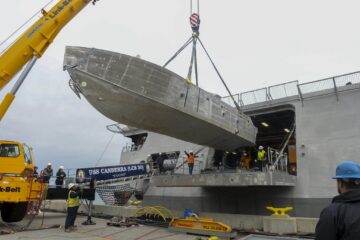Royal Navy press release
The three boats joined RFA Stirling Castle in Portland, Dorset, for a series of tests as the navy looks to adopt autonomous minehunting systems.
Royal Navy Motor Boats Apollo, Hydra and Hazard zipped around the water off the south coast as part of initial loading trials with the recently-purchased Royal Fleet Auxiliary ship. The trials were carried out alongside partners Defence Equipment & Support (DE&S), the procurement arm of the Ministry of Defence.
The main aim of the week was to prove autonomous vessels could be hosted on board Stirling Castle and eventually controlled or remotely-piloted from the ship. This will be the norm for the ship when she officially joins the RFA fleet following a naming ceremony in August and deploys on operations.
Using autonomous and uncrewed equipment removes the threat to naval personnel by keeping them well away from the minefield, leaving robots systems to do the legwork. It also allows more extensive searches of the sea.
And as well as the UK’s Mine Hunting Capability programme being at the cutting edge of autonomous systems technology, the development and manufacture of the autonomous boats and their payloads has created and supported almost 300 jobs in the UK – delivering on the Prime Minister’s priority of growing the economy through the creation of highly skilled jobs.

“These trials marks a key milestone in the delivery of the Royal Navy’s Mine Hunting Capability programme. Following her rapid procurement and delivery at the start of the year, RFA Stirling Castle has now embarked her first autonomous mine countermeasures systems. This has been achieved through the hard work of her ship’s company, the Maritime Autonomous System Trials Team, the Defence Equipment and Support delivery team, and our industry partners We can now look forward to having Maritime Autonomous Systems permanently embarked and ready for operations over the coming months.”
Rear Admiral Ivan Finn, Director UK royal Navy Acquisition
The navy’s Maritime Autonomous Systems Trials Team (MASTT) embarked on Stirling Castle to oversee the week-long trials and were pleased with the initial fusing of ship and autonomous boats.
Lieutenant Commander Jason Munson, Officer in Charge of MASTT, said: “The trials marked a significant milestone in the Mine Hunting Capability Programme. Operating from a host platform will allow our autonomous vessels to be used in a wider range of environment.
“The integration with RFA crew has been really successful, and the lessons learnt will contribute to getting this equipment to the front line.”
Andy Lapsley, DE&S Mine Hunting Capability (MHC) Team Leader, added: “This is an important step in the incremental development of maritime autonomous systems, exploiting new technology to increase performance and reduce risk to sailors.

“This event was a truly collaborative endeavour across various DE&S departments, the Royal Navy, the Royal Fleet Auxiliary and industry partners. It paves the way for significant advances in the global deployment of this capability.”
Stirling Castle joined the Royal Auxiliary Fleet to act as a “mothership” for autonomous minehunting systems. When operational, the ship will launch and recover the vessels, as well as analyse the data they gather while scouring home waters for mines and underwater explosive devices.
In doing so, the ship and the autonomous boats will begin to replace traditional mine countermeasures vessels, instead exploiting a series of advanced payloads such as towed sonars and remotely-operated neutralisation systems from a Remote Command Centre.






